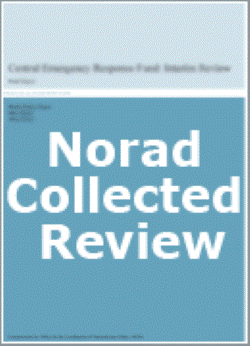Southern Africa Counter- Trafficking Programme (SACTP) Review
Om publikasjonen
- Utgitt: oktober 2010
- Serie: Norad-innsamlede rapporter
- Type: --
- Utført av: Liv Tørres, NCG (team leader) and Denise du Toit
- Bestilt av: Norwegian Embassy in Pretoria and Norad
- Land: Sør-Afrika
- Tema: Migrasjon (inkludert urbanisering)
- Antall sider: 58
- Serienummer: 6/2010
- ISBN: 978-82-7548-520-3
- ISSN: --

The Project
The International Organisation of Migration (IOM) started up the SACTAP programme in 2003. The budget was a little less than USD 2 millions (2003 – 2005) and had Norwegian, US and South African funding.
SACTAP II (2006 – 2009) was developed as the second phase of the programme, focussing on information and research, awareness raising, training, policy dialogue and protection of victims of trafficking in Southern Africa. The Norwegian Government came in as the main donor in line with Norwegian development aid priorities as well as the Norwegian Action Plan to Counter Human Trafficking (2007).
The counter trafficking programmes in the region were formed to a large extent on the basis of reports
published in 2000 (by Molo Songololo) and 2003 (IOM), arguing that there was an extensive and increasing human trafficking problem in Southern Africa. This was confirmed by other organisations.
Lately, several research centres have questioned these findings and argue that the problems of human trafficking may be relatively small compared to the large problems of smuggling and other forms of complex migration flows and exploitation. There is, however, a shortage of baseline data and information on which to evaluate the scale of human trafficking in Southern Africa and policy progress in the area.
Norway has contributed with a total of 35 million NOK since 2003. In the period 2006- 2009 Norway contributed with 27 million NOK.
Interesting Findings
- Lack of baseline information, surveys and data on human trafficking as well as good indicators on progress forms a major stumbling block to proper monitoring and evaluation of the IOM program. Baseline information, and research is a prerequisite for the elaboration, implementation and evaluation of antihuman trafficking strategies.
- IOM and the SACTAP programme has significantly contributed to the speeding up of the ratification of the Palermo Protocol and later development of anti-trafficking legislation in key countries in the region through the direct dialogue with key government officials, law enforcement officials and policy-makers.
- While it was a main goal in the SACTAP II to provide accurate and updated information on human trafficking in the region, this has not been sufficiently achieved at the time of the review. The agreed and planned survey of levels of awareness at the end of the programme period, would have given comparative data for evaluation, but did not take place. Similarly, the survey of the scale of trafficking in the region (with the ISS) was not finalised. This must be seen as a non-delivery from the programme.
- An impressive amount of information tools and public awareness campaigns have been developed. There are also good indications that the media campaigns have had an overall impact although this cannot be quantified. The information campaigns receive good evaluation from recognised training institutes like the ITC-ILO and stakeholders (in South Africa and outside) argue that the campaigns have contributed to increased attention, awareness and priority to the issue of human trafficking. Future activities would benefit from professional measurement of effectiveness of different communication channels.
- A broad spectre of government officials has received training: both law enforcement officers as well as social workers, department of health and hospital employees et al. For some government departments, such as the SA Police, the Department of Health etc. the training has undoubtedly contributed to institutional capacity, strategising and improved planning. While progress seems to have taken place in terms of large and impressive numbers of people being trained, there are still considerable challenges and needs left. Several hundred people from civil society have been trained, contributing also to an increased capacity at the grass root level to recognise and assist victims of trafficking.
- Regarding victims assistance, a good referral system seems to be in place between IOM and the NGO shelters. The system is reported to work well also between the police, health personnel etc., the IOM and shelters. Close to 20 shelters in the region form part of the IOM network, i.e. the capacity of shelters approved for victims of trafficking has increased. 15 of the shelters are in South Africa and additional shelters in Zimbabwe, Zambia and DRC. IOM is also part of the South African Shelter network established by Department of Social Development. About 300 victims have been assisted through the programme with shelter, medical assistance, counselling etc. 57 children (victims of trafficking) were assisted.
- The economic stabilization programme seems, in the short-term, to have had an impact in reducing the risk of trafficking for the women included in the programme. However, we know little about how high the risks were for these women in the first place. Furthermore, with huge numbers of poor and needy women at risk combined with limited programme funds, resources should rather be spent where they could have more direct and broader effects on reducing human trafficking.
- More efforts should be invested in developing the regional profile of the programme. SACTAP is still to a large extent a South African programme. Success has not been achieved on the development of a regional strategy or the establishment of an overall regional SADC task team. Limited success here may, however, not necessarily be the result of failed initiatives from the side of the IOM, but to low political priority on the side of the SADC governments. Priority should be given to a government-led regional strategy in the following.
